Chiến lược điều khiển tốc độ mới dựa trên logic mờ kiểu Pi và PSO cho các động cơ từ trở thay đổi
Bài báo này đề xuất một chiến lược điều khiển tốc độ mới cho các hệ truyền động sử dụng động cơ từ trở thay đổi loại 10/8 sử dụng thuật toán tối ưu hóa bầy đàn (PSO) và lý thuyết điều khiển mờ. Thuật toán tối ưu hóa PSO với ưu điểm nổi bật như cơ chế làm việc đơn giản và hiệu quả cao sẽ được áp dụng để tối ưu hóa một số tham số quan trọng của bộ điều khiển tốc độ mờ kiểu PI như các hàm thuộc và hệ số chỉnh định đầu ra. Thuật toán này cũng được sử dụng để xác định các góc chuyển mạch tối ưu cho một bộ biến đổi áp DC/DC không đối xứng cấp nguồn cho động cơ từ trở thay đổi loại 10/8 nói trên. Giải thuật tối ưu hóa PSO sử dụng trong nghiên cứu này sẽ bao gồm 12 biến, và quá trình tối ưu hóa được thực hiện thông qua 5 bước được đề xuất chi tiết trong bài báo. Sự hội tụ của thuật toán tối ưu PSO đã đưa ra các tham số tối ưu hiệu quả cho thiết kế bộ điều khiển mờ kiểu PI cũng như xác định được các góc chuyển mạch van hợp lý nhất. Quá trình mô phỏng sử dụng nhiều điều kiện khác nhau của phụ tải được thực hiện để minh chứng cho sự hiệu quả và đặc tính vượt trội của giải pháp điều khiển đã đề xuất so với phương pháp điều khiển kinh điển sử dụng bộ điều chỉnh PI truyền thống. Các kết quả mô phỏng khẳng định giải pháp điều khiển mới đưa ra trong nghiên cứu này là một phương pháp tối ưu hiệu quả trong việc thiết kế bộ điều khiển tốc độ thông minh cho các hệ truyền động sử dụng động cơ từ trở thay đổi loại 10/8 trong thực tế.
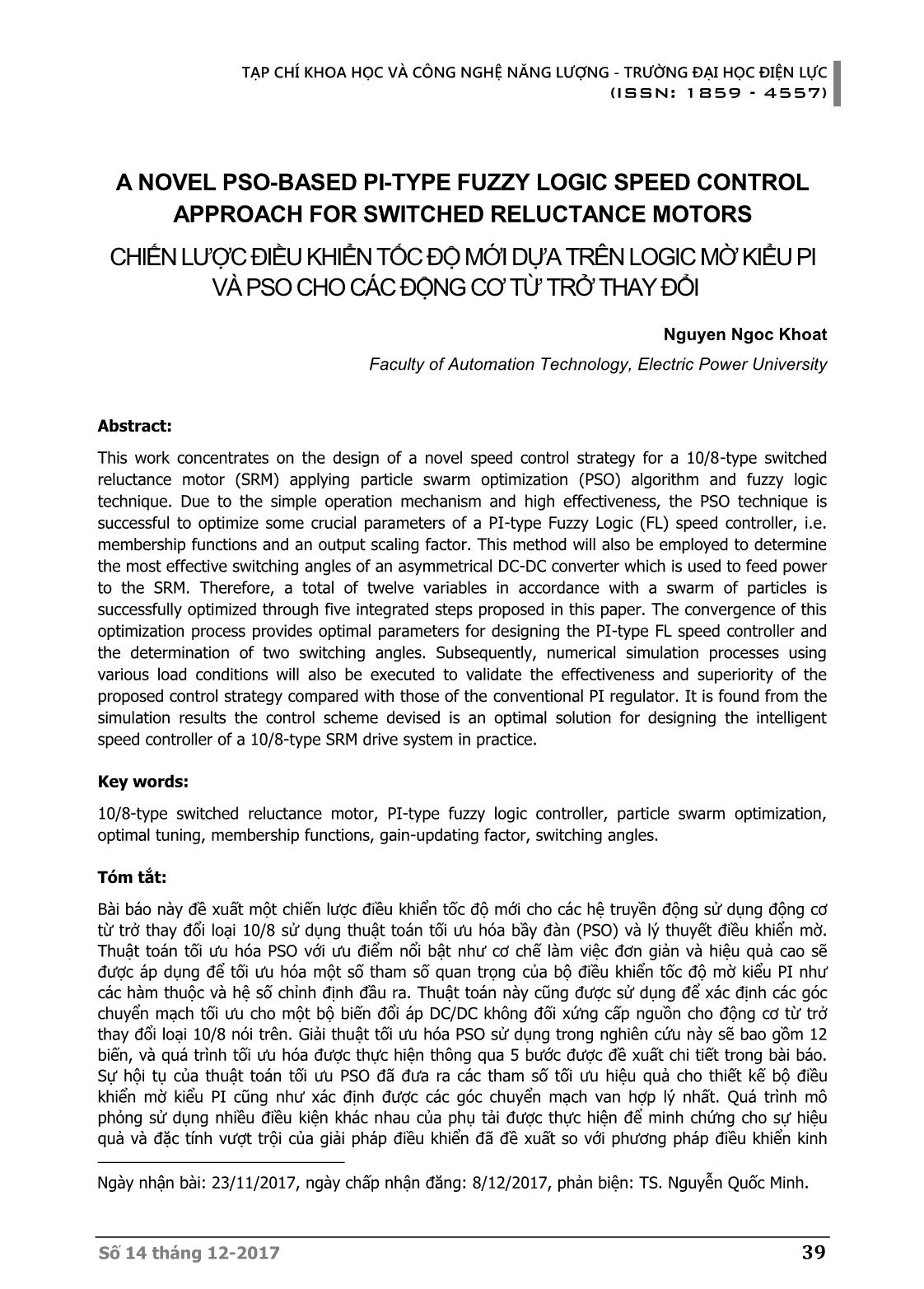
Trang 1
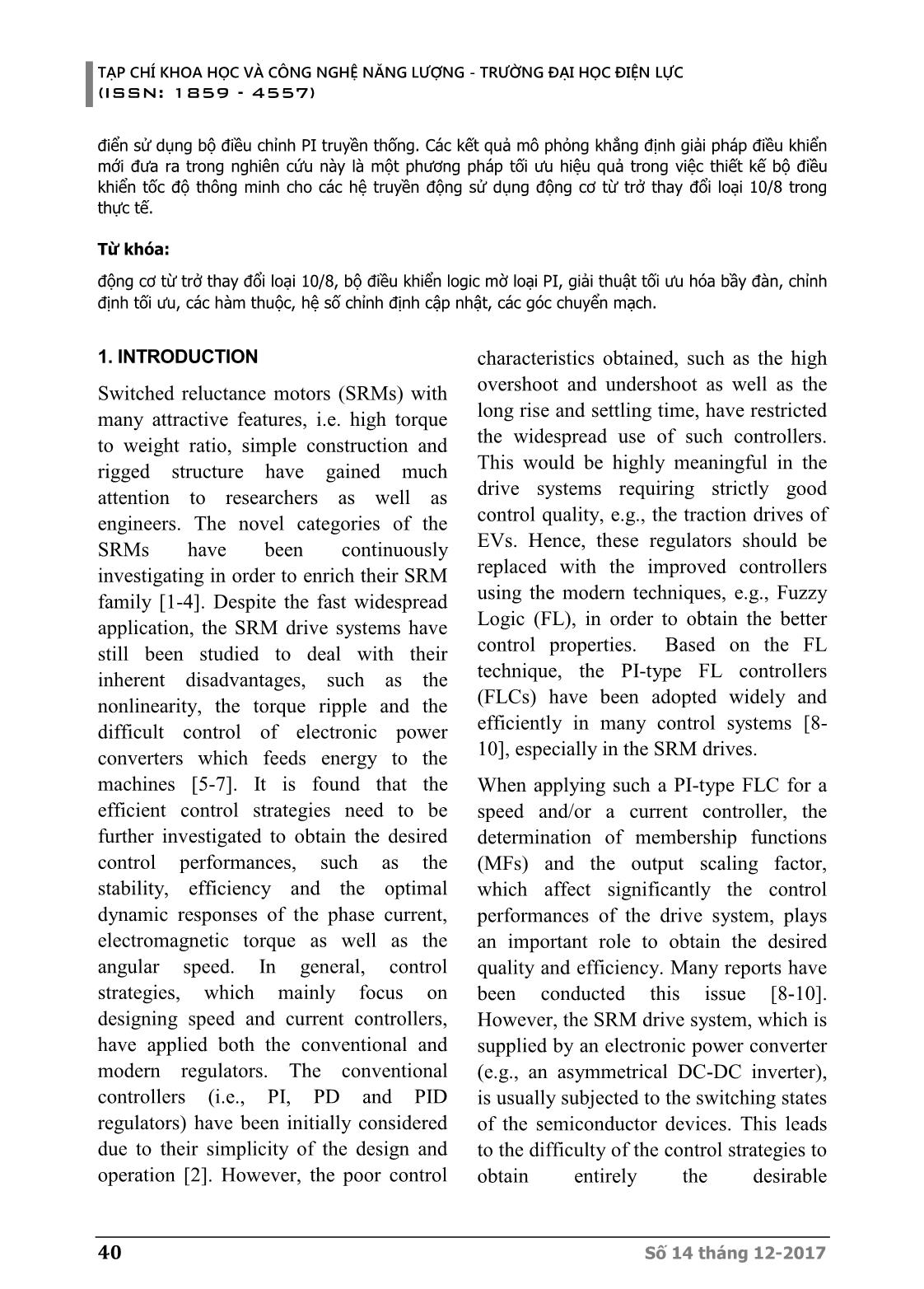
Trang 2
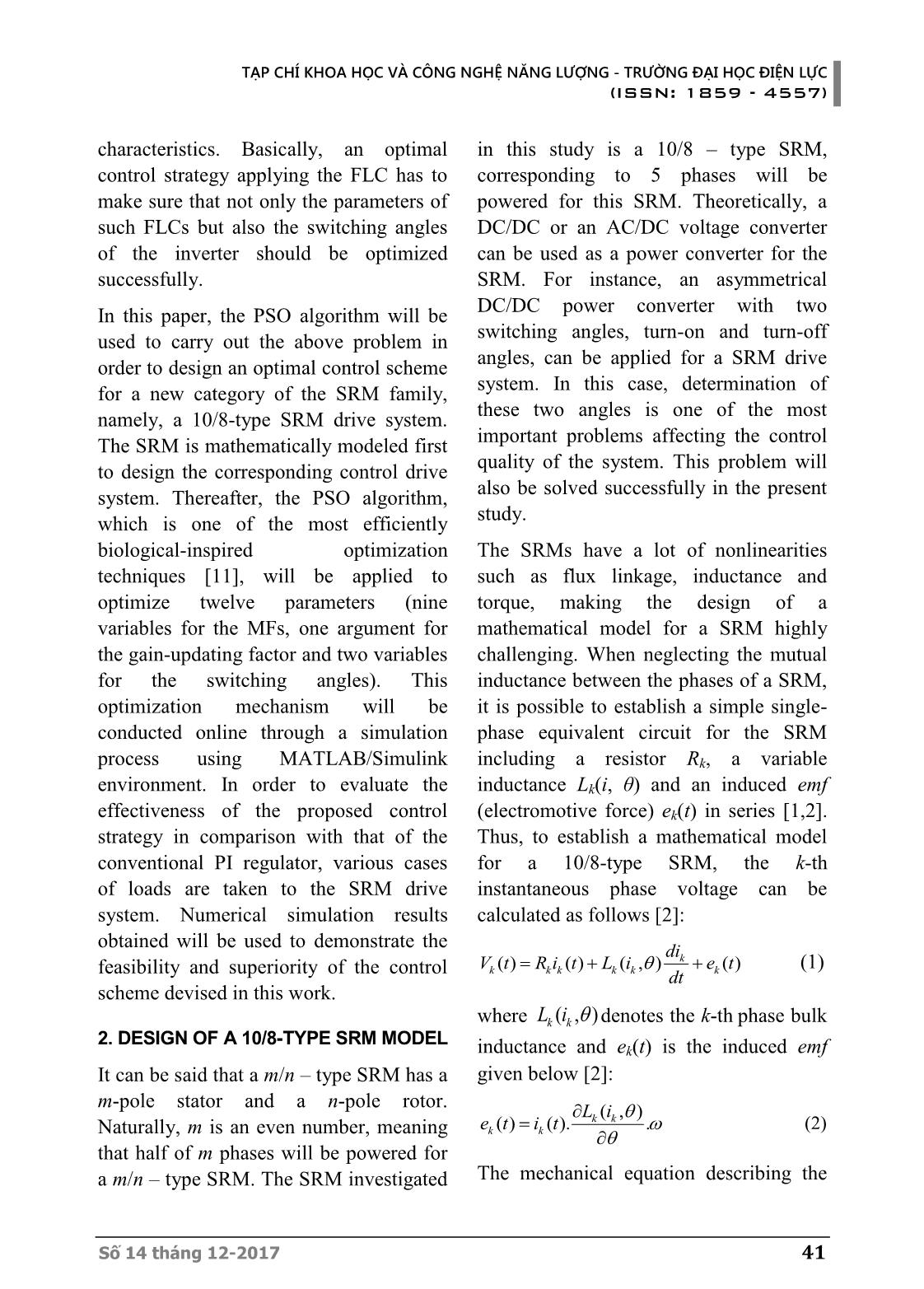
Trang 3
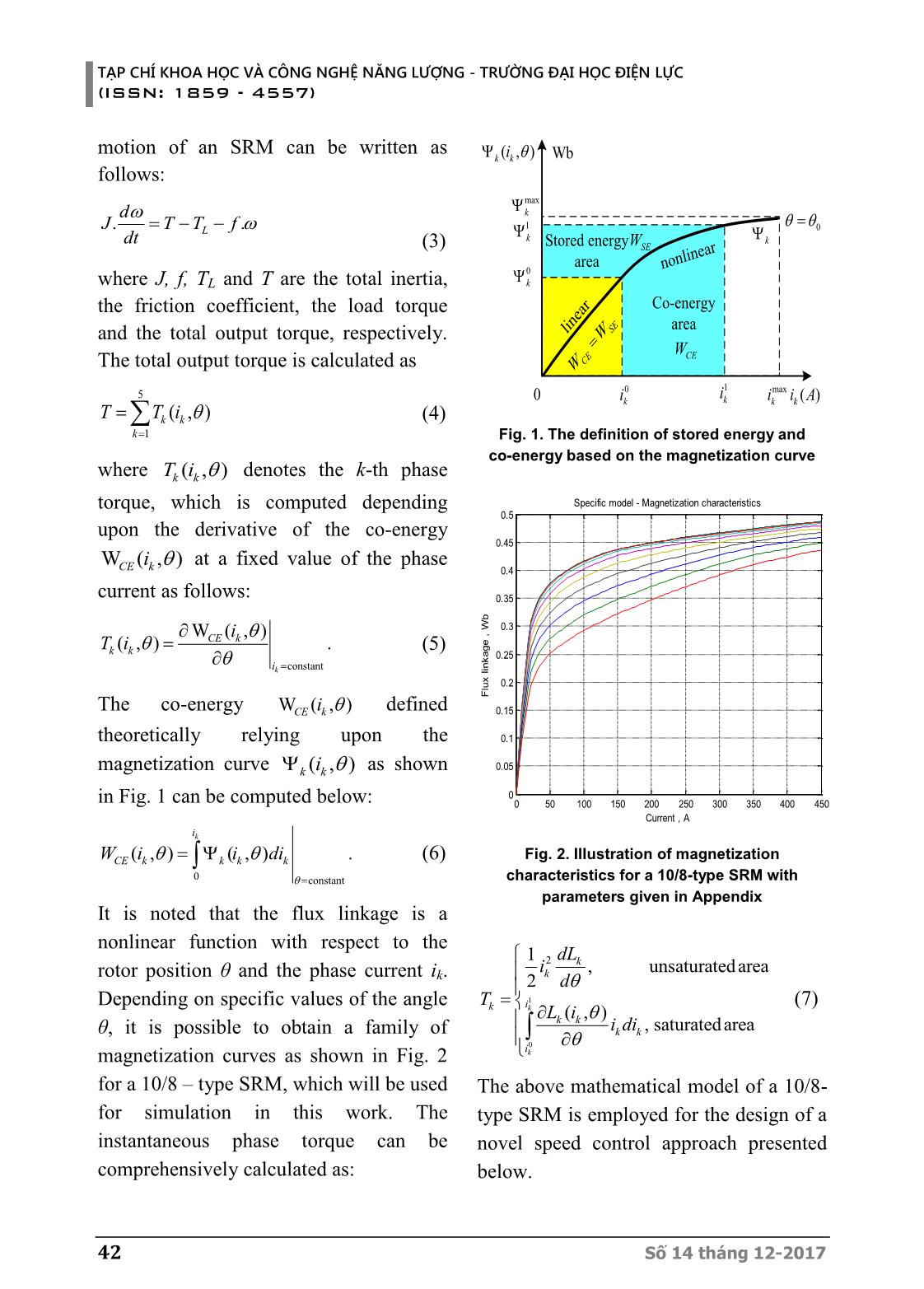
Trang 4
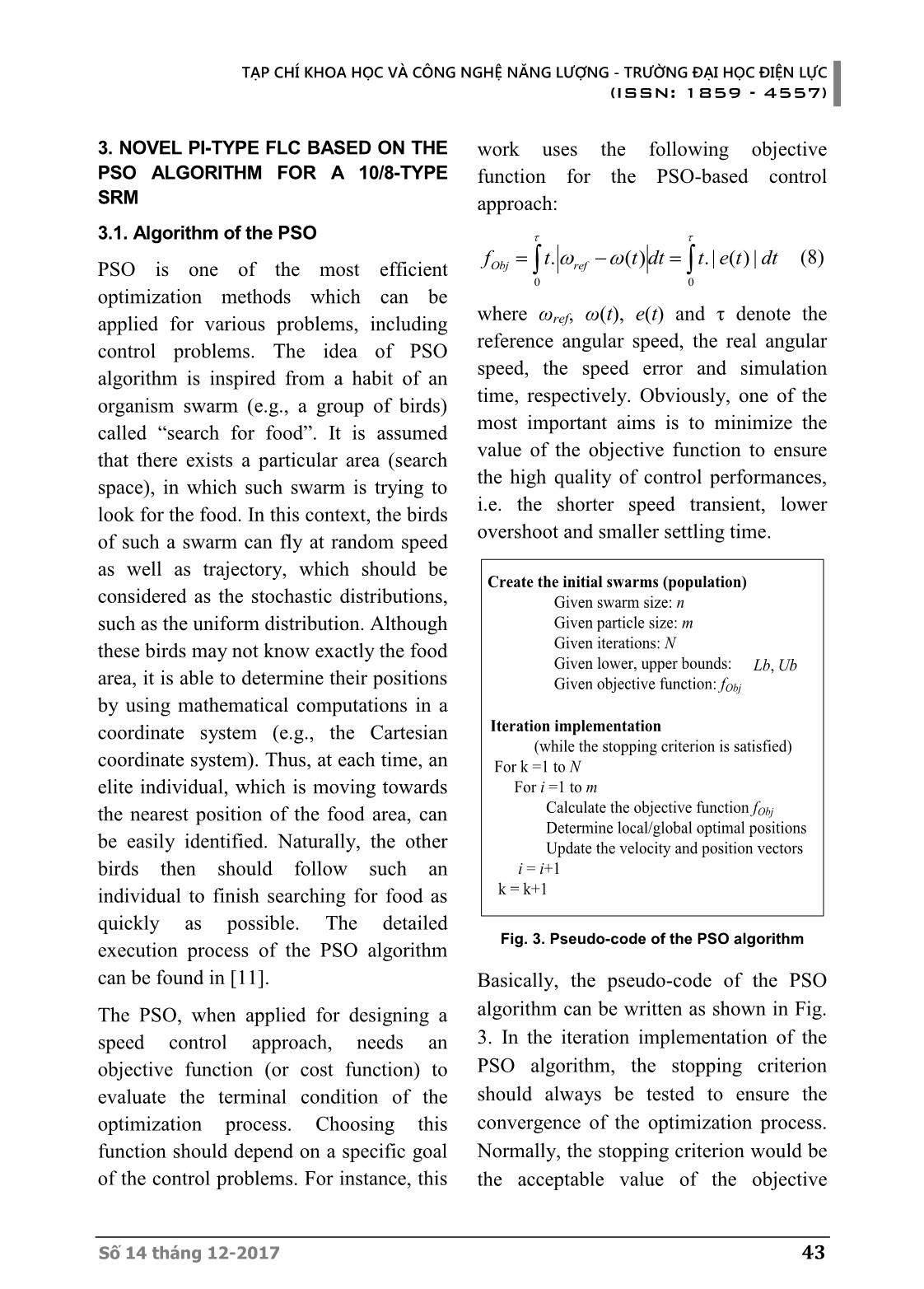
Trang 5
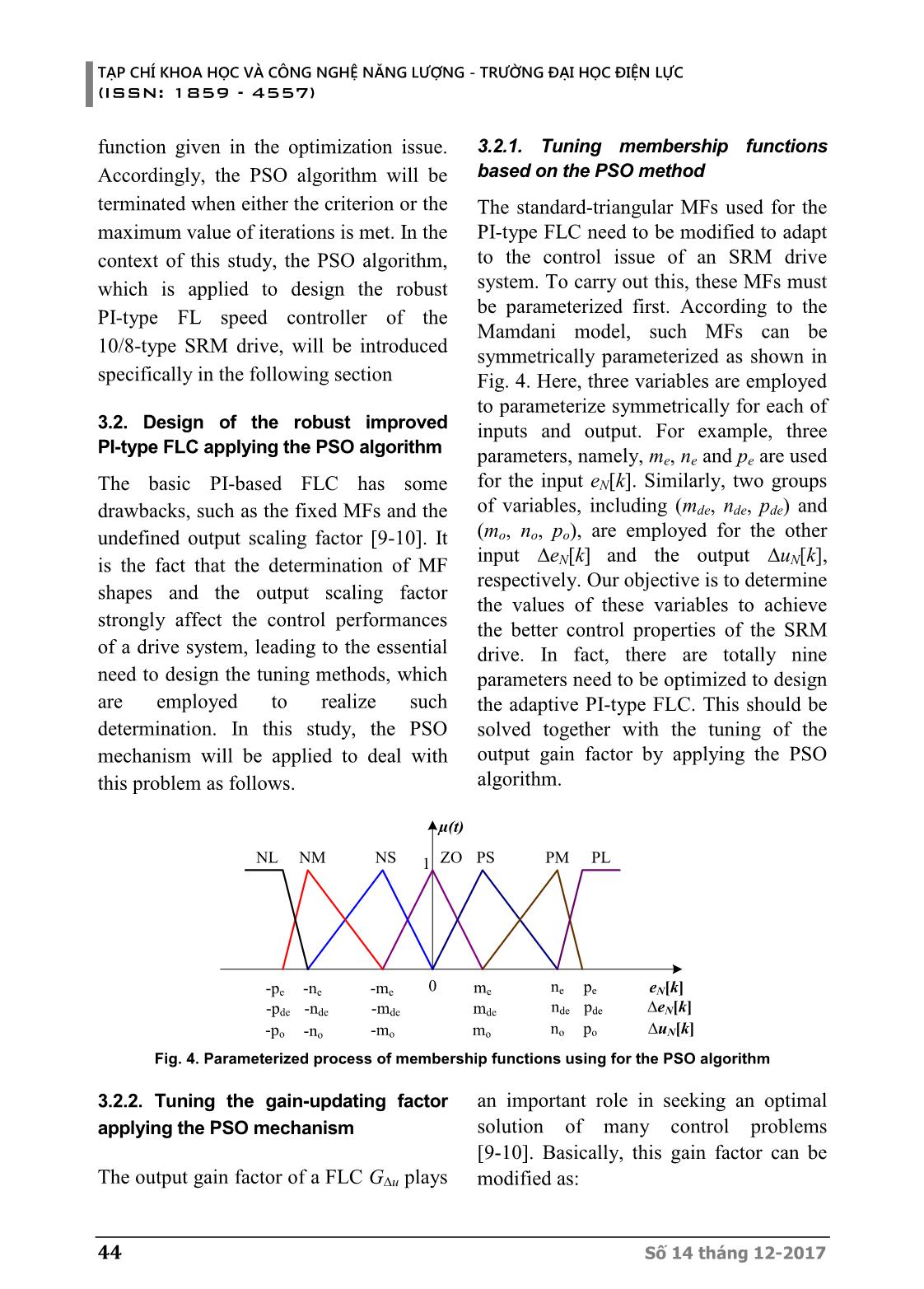
Trang 6
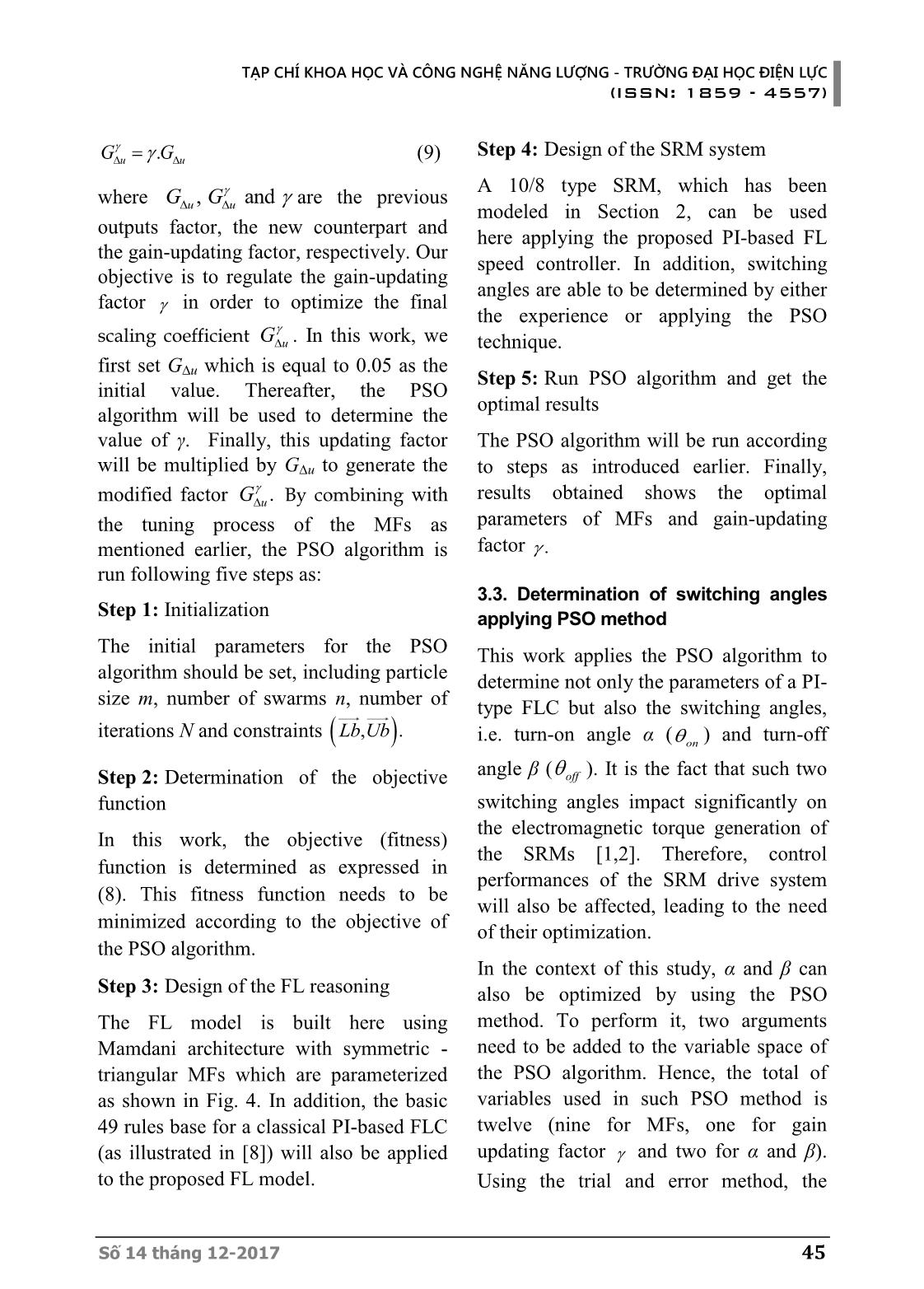
Trang 7
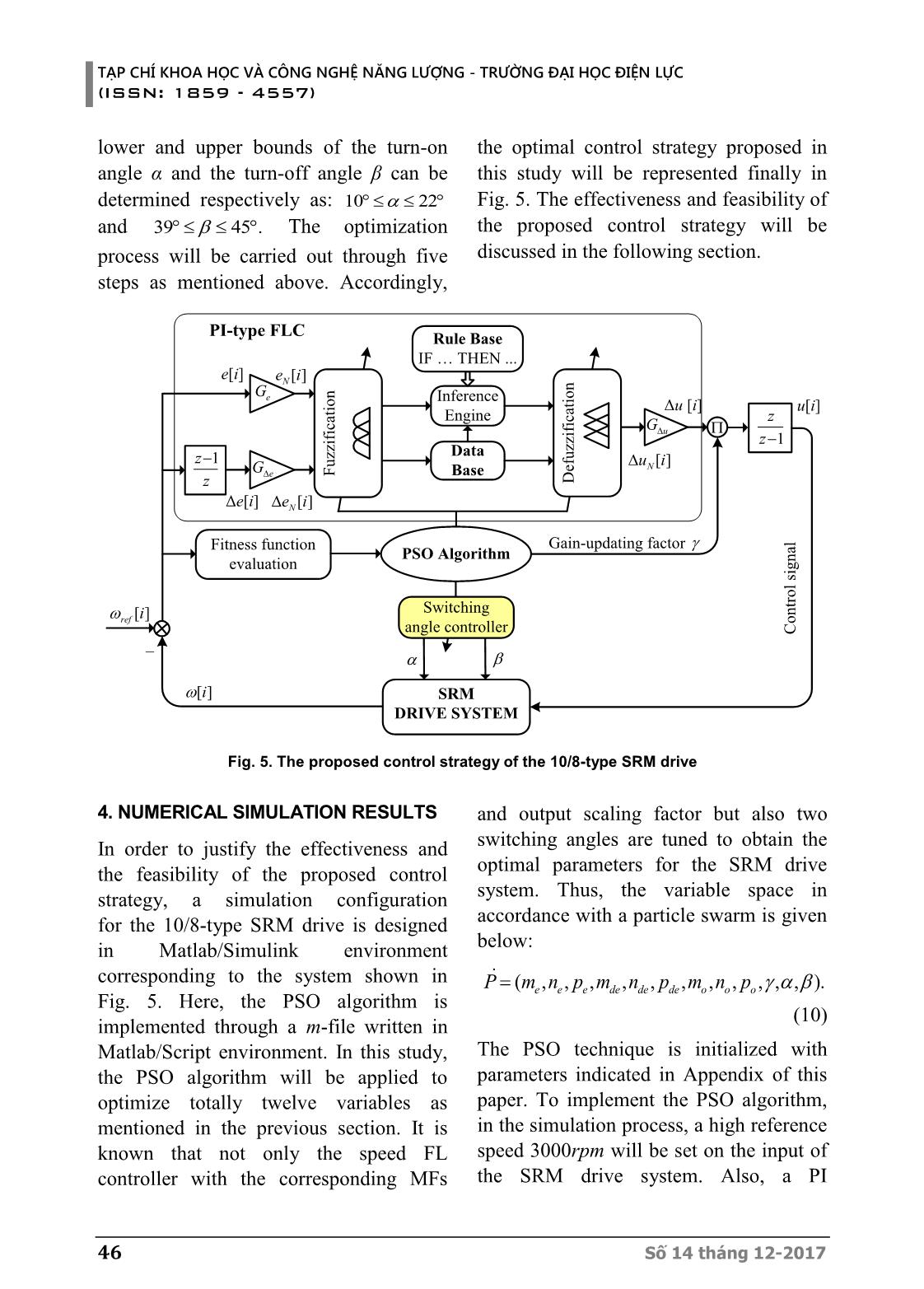
Trang 8
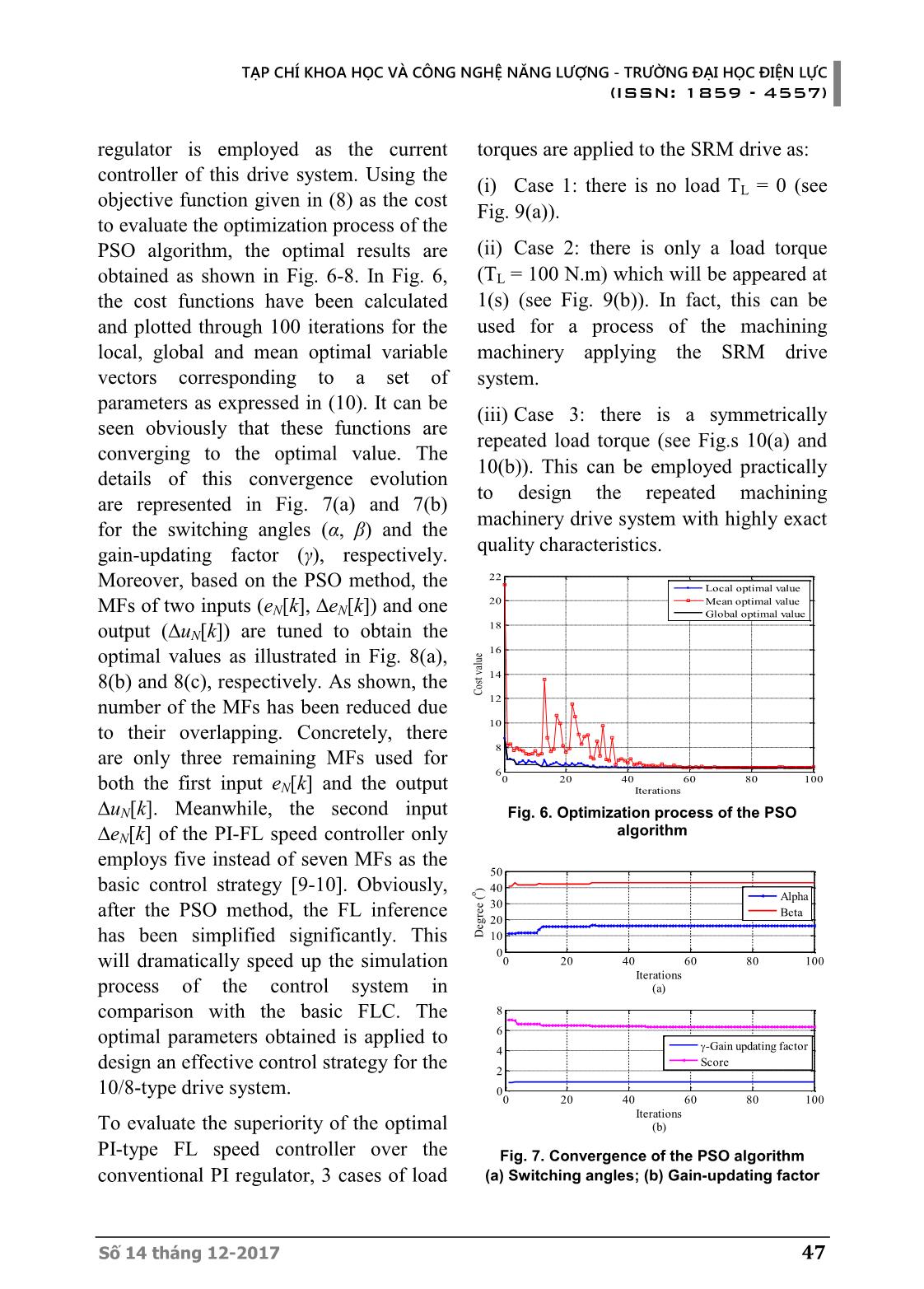
Trang 9
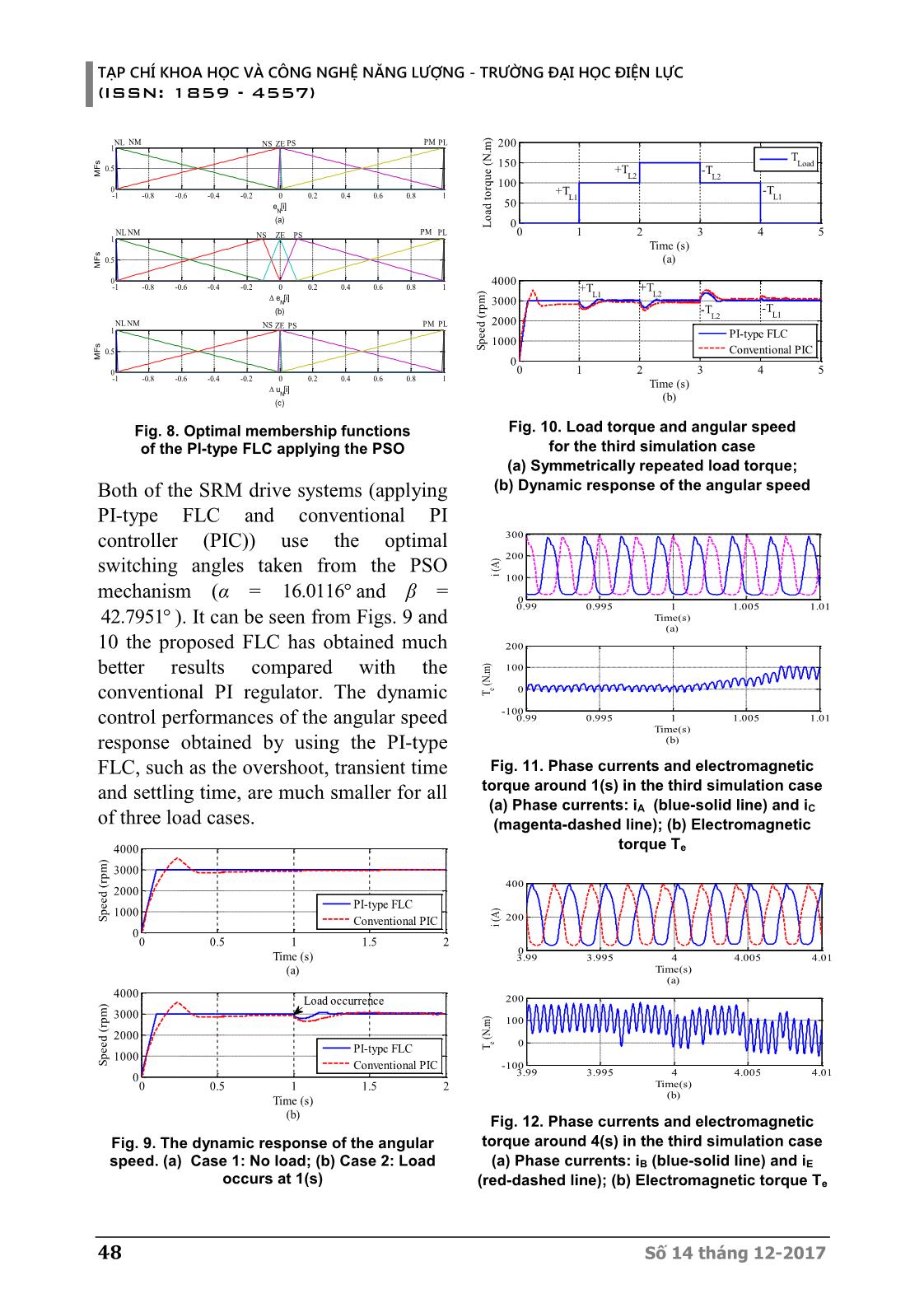
Trang 10
Tải về để xem bản đầy đủ
Tóm tắt nội dung tài liệu: Chiến lược điều khiển tốc độ mới dựa trên logic mờ kiểu Pi và PSO cho các động cơ từ trở thay đổi
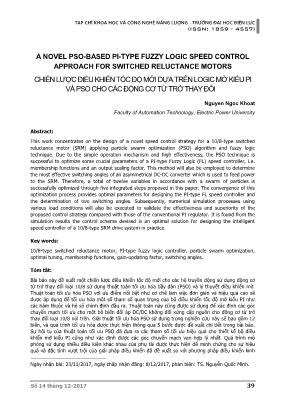
TẠP CHÍ KHOA HỌC VÀ CÔNG NGHỆ NĂNG LƯỢNG - TRƯỜNG ĐẠI HỌC ĐIỆN LỰC (ISSN: 1859 - 4557) Số 14 tháng 12-2017 39 A NOVEL PSO-BASED PI-TYPE FUZZY LOGIC SPEED CONTROL APPROACH FOR SWITCHED RELUCTANCE MOTORS CHIẾN LƯỢC ĐIỀU KHIỂN TỐC ĐỘ MỚI DỰA TRÊN LOGIC MỜ KIỂU PI VÀ PSO CHO CÁC ĐỘNG CƠ TỪ TRỞ THAY ĐỔI Nguyen Ngoc Khoat Faculty of Automation Technology, Electric Power University Abstract: This work concentrates on the design of a novel speed control strategy for a 10/8-type switched reluctance motor (SRM) applying particle swarm optimization (PSO) algorithm and fuzzy logic technique. Due to the simple operation mechanism and high effectiveness, the PSO technique is successful to optimize some crucial parameters of a PI-type Fuzzy Logic (FL) speed controller, i.e. membership functions and an output scaling factor. This method will also be employed to determine the most effective switching angles of an asymmetrical DC-DC converter which is used to feed power to the SRM. Therefore, a total of twelve variables in accordance with a swarm of particles is successfully optimized through five integrated steps proposed in this paper. The convergence of this optimization process provides optimal parameters for designing the PI-type FL speed controller and the determination of two switching angles. Subsequently, numerical simulation processes using various load conditions will also be executed to validate the effectiveness and superiority of the proposed control strategy compared with those of the conventional PI regulator. It is found from the simulation results the control scheme devised is an optimal solution for designing the intelligent speed controller of a 10/8-type SRM drive system in practice. Key words: 10/8-type switched reluctance motor, PI-type fuzzy logic controller, particle swarm optimization, optimal tuning, membership functions, gain-updating factor, switching angles. Tóm tắt: 6 Bài báo này đề xuất một chiến lược điều khiển tốc độ mới cho các hệ truyền động sử dụng động cơ từ trở thay đổi loại 10/8 sử dụng thuật toán tối ưu hóa bầy đàn (PSO) và lý thuyết điều khiển mờ. Thuật toán tối ưu hóa PSO với ưu điểm nổi bật như cơ chế làm việc đơn giản và hiệu quả cao sẽ được áp dụng để tối ưu hóa một số tham số quan trọng của bộ điều khiển tốc độ mờ kiểu PI như các hàm thuộc và hệ số chỉnh định đầu ra. Thuật toán này cũng được sử dụng để xác định các góc chuyển mạch tối ưu cho một bộ biến đổi áp DC/DC không đối xứng cấp nguồn cho động cơ từ trở thay đổi loại 10/8 nói trên. Giải thuật tối ưu hóa PSO sử dụng trong nghiên cứu này sẽ bao gồm 12 biến, và quá trình tối ưu hóa được thực hiện thông qua 5 bước được đề xuất chi tiết trong bài báo. Sự hội tụ của thuật toán tối ưu PSO đã đưa ra các tham số tối ưu hiệu quả cho thiết kế bộ điều khiển mờ kiểu PI cũng như xác định được các góc chuyển mạch van hợp lý nhất. Quá trình mô phỏng sử dụng nhiều điều kiện khác nhau của phụ tải được thực hiện để minh chứng cho sự hiệu quả và đặc tính vượt trội của giải pháp điều khiển đã đề xuất so với phương pháp điều khiển kinh 6Ngày nhận bài: 23/11/2017, ngày chấp nhận đăng: 8/12/2017, phản biện: TS. Nguyễn Quốc Minh. TẠP CHÍ KHOA HỌC VÀ CÔNG NGHỆ NĂNG LƯỢNG - TRƯỜNG ĐẠI HỌC ĐIỆN LỰC (ISSN: 1859 - 4557) 40 Số 14 tháng 12-2017 điển sử dụng bộ điều chỉnh PI truyền thống. Các kết quả mô phỏng khẳng định giải pháp điều khiển mới đưa ra trong nghiên cứu này là một phương pháp tối ưu hiệu quả trong việc thiết kế bộ điều khiển tốc độ thông minh cho các hệ truyền động sử dụng động cơ từ trở thay đổi loại 10/8 trong thực tế. Từ khóa: động cơ từ trở thay đổi loại 10/8, bộ điều khiển logic mờ loại PI, giải thuật tối ưu hóa bầy đàn, chỉnh định tối ưu, các hàm thuộc, hệ số chỉnh định cập nhật, các góc chuyển mạch. 1. INTRODUCTION Switched reluctance motors (SRMs) with many attractive features, i.e. high torque to weight ratio, simple construction and rigged structure have gained much attention to researchers as well as engineers. The novel categories of the SRMs have been continuously investigating in order to enrich their SRM family [1-4]. Despite the fast widespread application, the SRM drive systems have still been studied to deal with their inherent disadvantages, such as the nonlinearity, the torque ripple and the difficult control of electronic power converters which feeds energy to the machines [5-7]. It is found that the efficient control strategies need to be further investigated to obtain the desired control performances, such as the stability, efficiency and the optimal dynamic responses of the phase current, electromagnetic torque as well as the angular speed. In general, control strategies, which mainly focus on designing speed and current controllers, have applied both the conventional and modern regulators. The conventional controllers (i.e., PI, PD and PID regulators) have be ... By combining with the tuning process of the MFs as mentioned earlier, the PSO algorithm is run following five steps as: Step 1: Initialization The initial parameters for the PSO algorithm should be set, including particle size m, number of swarms n, number of iterations N and constraints , .Lb Ub Step 2: Determination of the objective function In this work, the objective (fitness) function is determined as expressed in (8). This fitness function needs to be minimized according to the objective of the PSO algorithm. Step 3: Design of the FL reasoning The FL model is built here using Mamdani architecture with symmetric - triangular MFs which are parameterized as shown in Fig. 4. In addition, the basic 49 rules base for a classical PI-based FLC (as illustrated in [8]) will also be applied to the proposed FL model. Step 4: Design of the SRM system A 10/8 type SRM, which has been modeled in Section 2, can be used here applying the proposed PI-based FL speed controller. In addition, switching angles are able to be determined by either the experience or applying the PSO technique. Step 5: Run PSO algorithm and get the optimal results The PSO algorithm will be run according to steps as introduced earlier. Finally, results obtained shows the optimal parameters of MFs and gain-updating factor . 3.3. Determination of switching angles applying PSO method This work applies the PSO algorithm to determine not only the parameters of a PI- type FLC but also the switching angles, i.e. turn-on angle α ( on ) and turn-off angle β ( off ). It is the fact that such two switching angles impact significantly on the electromagnetic torque generation of the SRMs [1,2]. Therefore, control performances of the SRM drive system will also be affected, leading to the need of their optimization. In the context of this study, α and β can also be optimized by using the PSO method. To perform it, two arguments need to be added to the variable space of the PSO algorithm. Hence, the total of variables used in such PSO method is twelve (nine for MFs, one for gain updating factor and two for α and β). Using the trial and error method, the TẠP CHÍ KHOA HỌC VÀ CÔNG NGHỆ NĂNG LƯỢNG - TRƯỜNG ĐẠI HỌC ĐIỆN LỰC (ISSN: 1859 - 4557) 46 Số 14 tháng 12-2017 lower and upper bounds of the turn-on angle α and the turn-off angle β can be determined respectively as: 10 22 and 39 45 . The optimization process will be carried out through five steps as mentioned above. Accordingly, the optimal control strategy proposed in this study will be represented finally in Fig. 5. The effectiveness and feasibility of the proposed control strategy will be discussed in the following section. Δe[i] u[i] Inference Engine Data Base 1 z z uG eG eG e[i] Δu [i] 1z z F u zz if ic at io n Rule Base IF THEN ... [ ]Nu i C o n tr o l si g n al SRM DRIVE SYSTEM PSO Algorithm Gain-updating factor Fitness function evaluation [ ]ref i _ [ ]i [ ]Ne i [ ]Ne i PI-type FLC Switching angle controller D ef u zz if ic at io n Fig. 5. The proposed control strategy of the 10/8-type SRM drive 4. NUMERICAL SIMULATION RESULTS In order to justify the effectiveness and the feasibility of the proposed control strategy, a simulation configuration for the 10/8-type SRM drive is designed in Matlab/Simulink environment corresponding to the system shown in Fig. 5. Here, the PSO algorithm is implemented through a m-file written in Matlab/Script environment. In this study, the PSO algorithm will be applied to optimize totally twelve variables as mentioned in the previous section. It is known that not only the speed FL controller with the corresponding MFs and output scaling factor but also two switching angles are tuned to obtain the optimal parameters for the SRM drive system. Thus, the variable space in accordance with a particle swarm is given below: ( , , , , , , , , , , , ).e e e de de de o o oP m n p m n p m n p (10) The PSO technique is initialized with parameters indicated in Appendix of this paper. To implement the PSO algorithm, in the simulation process, a high reference speed 3000rpm will be set on the input of the SRM drive system. Also, a PI TẠP CHÍ KHOA HỌC VÀ CÔNG NGHỆ NĂNG LƯỢNG - TRƯỜNG ĐẠI HỌC ĐIỆN LỰC (ISSN: 1859 - 4557) Số 14 tháng 12-2017 47 regulator is employed as the current controller of this drive system. Using the objective function given in (8) as the cost to evaluate the optimization process of the PSO algorithm, the optimal results are obtained as shown in Fig. 6-8. In Fig. 6, the cost functions have been calculated and plotted through 100 iterations for the local, global and mean optimal variable vectors corresponding to a set of parameters as expressed in (10). It can be seen obviously that these functions are converging to the optimal value. The details of this convergence evolution are represented in Fig. 7(a) and 7(b) for the switching angles (α, β) and the gain-updating factor (γ), respectively. Moreover, based on the PSO method, the MFs of two inputs (eN[k], ∆eN[k]) and one output (∆uN[k]) are tuned to obtain the optimal values as illustrated in Fig. 8(a), 8(b) and 8(c), respectively. As shown, the number of the MFs has been reduced due to their overlapping. Concretely, there are only three remaining MFs used for both the first input eN[k] and the output ∆uN[k]. Meanwhile, the second input ∆eN[k] of the PI-FL speed controller only employs five instead of seven MFs as the basic control strategy [9-10]. Obviously, after the PSO method, the FL inference has been simplified significantly. This will dramatically speed up the simulation process of the control system in comparison with the basic FLC. The optimal parameters obtained is applied to design an effective control strategy for the 10/8-type drive system. To evaluate the superiority of the optimal PI-type FL speed controller over the conventional PI regulator, 3 cases of load torques are applied to the SRM drive as: (i) Case 1: there is no load TL = 0 (see Fig. 9(a)). (ii) Case 2: there is only a load torque (TL = 100 N.m) which will be appeared at 1(s) (see Fig. 9(b)). In fact, this can be used for a process of the machining machinery applying the SRM drive system. (iii) Case 3: there is a symmetrically repeated load torque (see Fig.s 10(a) and 10(b)). This can be employed practically to design the repeated machining machinery drive system with highly exact quality characteristics. Fig. 6. Optimization process of the PSO algorithm Fig. 7. Convergence of the PSO algorithm (a) Switching angles; (b) Gain-updating factor 0 20 40 60 80 100 6 8 10 12 14 16 18 20 22 Iterations C os t v al ue Local optimal value Mean optimal value Global optimal value 0 20 40 60 80 100 0 10 20 30 40 50 Iterations (a) D e g re e ( o ) Alpha Beta 0 20 40 60 80 100 0 2 4 6 8 Iterations (b) -Gain updating factor Score TẠP CHÍ KHOA HỌC VÀ CÔNG NGHỆ NĂNG LƯỢNG - TRƯỜNG ĐẠI HỌC ĐIỆN LỰC (ISSN: 1859 - 4557) 48 Số 14 tháng 12-2017 Fig. 8. Optimal membership functions of the PI-type FLC applying the PSO Both of the SRM drive systems (applying PI-type FLC and conventional PI controller (PIC)) use the optimal switching angles taken from the PSO mechanism (α = 16.0116 and β = 42.7951 ). It can be seen from Figs. 9 and 10 the proposed FLC has obtained much better results compared with the conventional PI regulator. The dynamic control performances of the angular speed response obtained by using the PI-type FLC, such as the overshoot, transient time and settling time, are much smaller for all of three load cases. Fig. 9. The dynamic response of the angular speed. (a) Case 1: No load; (b) Case 2: Load occurs at 1(s) Fig. 10. Load torque and angular speed for the third simulation case (a) Symmetrically repeated load torque; (b) Dynamic response of the angular speed Fig. 11. Phase currents and electromagnetic torque around 1(s) in the third simulation case (a) Phase currents: iA (blue-solid line) and iC (magenta-dashed line); (b) Electromagnetic torque Te Fig. 12. Phase currents and electromagnetic torque around 4(s) in the third simulation case (a) Phase currents: iB (blue-solid line) and iE (red-dashed line); (b) Electromagnetic torque Te -1 -0.8 -0.6 -0.4 -0.2 0 0.2 0.4 0.6 0.8 1 0 0.5 1 e N [i] (a) M F s NL NM NS ZE PS PM PL -1 -0.8 -0.6 -0.4 -0.2 0 0.2 0.4 0.6 0.8 1 0 0.5 1 e N [i] (b) M F s NL NM NS ZE PS PM PL -1 -0.8 -0.6 -0.4 -0.2 0 0.2 0.4 0.6 0.8 1 0 0.5 1 u N [i] (c) M F s NL NM NS ZE PS PM PL 0 0.5 1 1.5 2 0 1000 2000 3000 4000 Time (s) (a) S p e e d ( rp m ) PI-type FLC Conventional PIC 0 0.5 1 1.5 2 0 1000 2000 3000 4000 Time (s) (b) S p e e d ( rp m ) PI-type FLC Conventional PIC Load occurrence 0 1 2 3 4 5 0 50 100 150 200 Time (s) (a) L o a d t o rq u e ( N .m ) T Load 0 1 2 3 4 5 0 1000 2000 3000 4000 Time (s) (b) S p e e d ( rp m ) PI-type FLC Conventional PIC +T L1 +T L2 +T L2 +T L1 -T L2 -T L2 -T L1 -T L1 0.99 0.995 1 1.005 1.01 0 100 200 300 Time(s) (a) i ( A ) 0.99 0.995 1 1.005 1.01 -100 0 100 200 Time(s) (b) T e ( N .m ) 3.99 3.995 4 4.005 4.01 0 200 400 Time(s) (a) i ( A ) 3.99 3.995 4 4.005 4.01 -100 0 100 200 Time(s) (b) T e ( N .m ) TẠP CHÍ KHOA HỌC VÀ CÔNG NGHỆ NĂNG LƯỢNG - TRƯỜNG ĐẠI HỌC ĐIỆN LỰC (ISSN: 1859 - 4557) Số 14 tháng 12-2017 49 In addition, Fig. 11(a) and 11(b) illustrate the dynamic responses of current phases and electromagnetic torque around 1s corresponding to an increase of the load torque in the third simulation case. On the other hand, when load moment falls in the second time (at 4s), such two dynamic responses can be affected as shown in Fig. 12(a) and 12(b). It is found that the oscillations of the current phases are kept to be stable even though the electromagnetic torque is being affected by the change of the load. Indeed, this is very meaningful when designing the drive systems that require strictly high control characteristics, e.g., the electric traction drive systems of electric vehicles. 5. CONCLUSIONS AND DISCUSSIONS The efficient application of the PSO algorithm has been investigated in this paper to design the optimal PI-type FL speed controller for a 10/8-type SRM drive system. All of the MFs as well as the gain-updating factor of this FLC are optimized successfully. In addition, the PSO method is applied to determine the optimal switching angles of the asymmetrical DC-DC converter, which has been used to feed the power energy to the SRM drive. Using five integrated steps of the PSO technique proposed in this study, the optimization process has been implemented in order to design a highly feasible and efficient control strategy for the 10/8-SRM drive system. Through the simulation results obtained with various cases of loads, the superiority of the proposed control scheme has been demonstrated compared with the traditional counterpart using the PI regulator. It is well known that the control process has been outperformed efficiently enough to apply to various drive systems in reality. For future work, the investigation of different types of the SRM drive systems applying the optimal controllers, e.g., the PI-type FLC based on the PSO algorithm, should be considered. Moreover, a hybrid control strategy using the combination of fuzzy logic and neural network techniques based on means of the biological-inspired optimization will catch more attention to design an efficiently practical SRM system. Appendix 10/8-type SRM parameters 2 min max max 0.05 , 0.05 . , 0.02 . . , 0.67 , 23.6 , 500 k k k k R J kg m f N m s L mH L mH i A PSO parameters 10, 12, 100; [0,0,0,0,0,0,0,0,0,0,10,39]; 1,1,1,1,1,1,1,1,1,1,22,45 n m N Lb Ub ACKNOWLEDGMENT The authors wish to thank the editors and anonymous reviewers for their valuable comments, which will help to improve this study. TẠP CHÍ KHOA HỌC VÀ CÔNG NGHỆ NĂNG LƯỢNG - TRƯỜNG ĐẠI HỌC ĐIỆN LỰC (ISSN: 1859 - 4557) 50 Số 14 tháng 12-2017 REFERENCES [1] Ahmad M. High Performance AC Drives Modeling Analysis and Control. London, UK: Springer, 2010. [2] Krishnan R. Switched Reluctance Motor Driver: Modeling, Simulation, Analysis, Design, and Applications. New York, NY, USA: CRC Press, 2001. [3] Xue XD, Cheng KWE, Lin JK, Zhang Z, Luk KF, Ng TW, Cheung NC. Optimal control method of motoring operation for SRM drives in electric vehicles. IEEE T Veh Technol 2010; 59: 1191-1204. [4] Santos DFLM, Anthonis J, Naclerio F, Gyselinck JJC, Auweraer VDH, Goes LCS. Multiphysics NVH modeling: simulation of a switched reluctance motor for an electric vehicle. IEEE T Ind Electron 2014; 61: 469-476. [5] Sunan E, Kucuk F, Goto H, Guo HJ, Ichinokura O. Three-phase full-bridge converter controlled permanent magnet reluctance generator for small-scale wind energy conversion systems. IEEE T Energy Conver 2014; 29: 585-593. [6] Andrada P, Blanque B, Martinez E, Torrent M. A novel type of hybrid reluctance motor drive. IEEE T Ind Electron 2014; 61: 4337-4345. [7] Lee DH; Lee ZG, Liang J, Ahn JW. Single-phase SRM drive with torque Ripple reduction and power factor correction. IEEE T Ind Appl 2007; 43: 1578-1587. [8] Jihong L. On methods for improving performance of PI-type fuzzy logic controllers. IEEE T Fuzzy Syst 1993; 1: 298-301. [9] Bimal KB. Modern power electronics and AC drives. Upper Saddle River, NJ, USA: Prentice Hall PTR, 2002. [10] Mudi RK, Pal NR. A robust self-tuning scheme for PI- and PD-type fuzzy controllers. IEEE T Fuzzy Syst 1999; 7: 2-16. [11] Bevrani H, Habibi F, Babahajyani P, Watanabe M, Mitani Y. Intelligent frequency control in an AC microgrid: online PSO-based fuzzy tuning approach. IEEE T Smart Grid 2012; 3: 1935-1944. Biography: Nguyen Ngoc Khoat received the Msc degree in Automation and Control at Hanoi University of Science and Technology, in 2009. He received the PhD degree in Electronic Science and Technology at University of Electronic Science and Technology of China, in 2015. He is working as a lecturer and researcher at Faculty of Automation Technology, Electric Power University in Hanoi, Vietnam. His research interests include renewable energy, intelligent control, power electronics and smart electric drives systems.
File đính kèm:
 chien_luoc_dieu_khien_toc_do_moi_dua_tren_logic_mo_kieu_pi_v.pdf
chien_luoc_dieu_khien_toc_do_moi_dua_tren_logic_mo_kieu_pi_v.pdf

